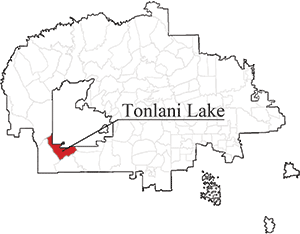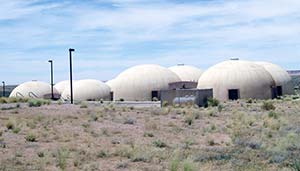Gunshooter, the orphans and the killing of The Bat
Barren Tolani Lake Chapter is rich in history
By Cindy Yurth
Tséyi' Bureau
(Editor's note: In an effort to chronicle the beauty and diversity of the Navajo Nation, as well as its issues, the Navajo Times has committed to visiting all 110 chapters in alphabetical order. This is the 89th in the series. Some information for this series is taken from the publication "Chapter Images" by Larry Rodgers.)
TOLANI LAKE, Ariz., June 5, 2014


(Times photo - Cindy Yurth)
These futuristic-looking domes were supposed to be teacher housing for a school in Tolani Lake, but the school closed before the teachers could move in, and they have been sitting vacant and vandalized for years.
In a desolate land, Tolani Lake may win the prize for the most desolate chapter.
The "lake," actually an intermittent flood plain, is long gone, possibly because of the drought and dams built upstream by the Hopis. Saharan sand dunes threaten to engulf roads and corrals.
Coming in the back way from Seba Dalkai, all you see in all directions is an almost frightening expanse of scrubby desert, the only landmark the stark ridge called Tsé Biwoo Ghiizhi (Rock Tooth Gap).
But stay a while and get to know this chapter and its proud people with royal blood. This barren landscape is rich in stories.
Dorothy Denetclaw lives in Indian Wells now, but her roots run deep in this area on her father's side. He was the son of Adilthdoney ("Gunshooter"), one of the few medicine men to specialize in the Red Ant Way.
Fortunately, the family passed along its history, which is also, to a large extent, the history of Tolani Lake.
According to Denetclaw, the area was first settled by the daughters of Chief Manuelito's younger brother, a headman of the Four Corners area who was known in Spanish as Carnero Mucho ("Many Rams") and in Ute as Sabighali ("Man with the Fast White Horse").
After the Long Walk, Sabighali had settled in the Newcomb, N.M., area where a Mexican prospector reportedly built his family a house in exchange for his guarding the prospector's gold-panning operation.
Sabighali's wife died while delivering twins. The late wife's brother adopted the twins and advised the four grief-stricken older children to go to their maternal aunt in Wheatfields, Ariz., who would help raise them.
Taking less-traveled routes to avoid Indian agents who would force them into boarding schools, the little band eventually arrived in Wheatfields.
When they were a little older, they struck out on their own, stopping for a few years in Chinle, where the teenage daughter fell in love with a notorious gambler and delivered yet another girl.
The other children continued on, this time toward the area south of the Hopi mesas where they were told they could raise sheep and trade them to the Hopis for their other necessities.
After settling in Tolani Lake, they went back for their errant sister in Chinle. Their uncle convinced her to leave the gambler, who was turning out not to be the best husband and father, and cast her lot with her siblings.
The orphans' Tl'aaschii clan is still prevalent in Tolani Lake today.
Meanwhile, the handsome Gunshooter, whose face graces post cards you can still buy today, was making a name for himself. He had learned the elaborate Red Ant Way from his grandfather, who had told him practitioners of the delicate ceremony must keep themselves spiritually and morally pure. He was known as a man of exceptional honor and frankness É which was soon to be sorely tested.
Gunshooter's family proposed marriage to Asdzaa Nez, the sister who had left Chinle, and the couple had several children in addition to the girl she brought with her.
Around the turn of the 20th Century, Denetclaw said, Gunshooter was hired by the U.S. Commissioner for Indian Affairs, Francis E. Leupp, as his liaison with the Navajo.
"That was the time Leupp was trying to hand out allotments," Denetclaw explained.
The law was that the land would go to the male head of household, which, according to Denetclaw, made the Diné women Ñ traditional owners of the family land Ñ furious.
"It was creating all kinds of marital discord," Denetclaw said. "The woman would say, 'Who is he (the husband)? Just an in-law who sometimes brings us a rabbit to cook!'"
Leupp's ambassador
Leupp needed someone on his side, someone the Navajos respected, and that was Gunshooter.
It was a good gig until March of 1919, when Gunshooter's two oldest teenage sons came to their father in a panic, telling him they had just killed Jaa' Aban’ ("The Bat").
The Bat was Charles Hubbell, the Tolani Lake trader so called because of his pointy, bat-like ears and pinched features. The boys explained an argument over change had escalated and Hubbell, who appeared to be drunk, had run to get his gun while one of the boys removed a loaded pistol from a display case.
Family history has the older brother firing in self-defense after Hubbell shot at the younger brother and the latter collapsed to the floor. The older brother, Denetclaw said, thought his sibling was dead when in reality he had just dropped to the floor to dodge the bullet.
Gunshooter was in a quandary. He had a responsible job with the Indian commissioner, and now his sons had killed the only other bilagáana in town. As a Red Ant Way practitioner, he couldn't lie or hide his children from the law. He decided he wouldn't hide them, but he wouldn't turn them in either.
Eventually, the sheriff came looking for the boys.
"Gunshooter said, 'Here are my children. I can't say they didn't do it,'" Denetclaw said.
The boys went to jail for a year and emerged speaking English and with new English names given to them by the warden: George and John Nells. One of them got a job driving a bus for the local school, and history does not record any more encounters with the law. Gunshooter kept his job.
"Everyone around here with the last name Nells is related to them," Denetclaw declared.
If you want to find the old trading post where Hubbell met his demise, good luck. The boys, in a panic, burned it to the ground and there is virtually nothing left of it. Few people these days even know the location of Jaa' Aban’ D’’lid’, "Where the Bat Burned."
Unfortunately, modern Tolani Lake has even fewer businesses than it did back then. Which is to say, none.
"It's probably our major problem," said Valerie Kelly, the chapter's community services coordinator. "Employment is very limited."
People commute to the schools and clinic of nearby Leupp, or endure an hour-and-a-half commute to Flagstaff or a 40-minute one to Winslow.
The community has taken the problem in hand, establishing a community development nonprofit called TóLání Enterprises to "foster and encourage Native American economic security, food security, community wellbeing, higher education, Native veterans' issues and the preservation of Native culture."
Many people here still ranch, and the ranchers have pooled their resources for a successful cattlemen's association that applies for USDA EQIP grants for stock tanks and such.
"We're really proud of our ranchers," Kelly said. "It's not easy to make it out here. They work together."
There is also a thriving veterans' organization, and, being an hour and a half from Northern Arizona University, this chapter gets so many scholarship requests Kelly has put the form online on the chapter's web site Ñ which she also keeps extraordinarily up-to-date.
The Domes
The first thing that catches your eye in the town of Tolani Lake is a weird juxtaposition of architecture.
Behind what appears to be an Anasazi ruin (but is actually the old elementary school) rises a series of off-white bubbles that conjure some sort of space colony.
"Oh, you mean The Domes," said Kelly. They're a bit of a sore spot.
"They were supposed to be teacher housing for a school that was here," Kelly explained. "But the school folded before the teachers could move in."
Since then, the perfectly functional housing continues to be vandalized, although a chain-link fence has been built around it.
"The chapter is in the process of getting the land back so we can ask NHA to rehabilitate them," Kelly said. "They're actually quite nice."
Housing is a problem the 647-member chapter can finally start to solve, with the thawing of the Bennett Freeze and money starting to flow to that area with its daunting needs. A roofing project is currently under way.
Land status remains an issue in this chapter that lost a third of its land base in the 1974 Navajo-Hopi land partition.
"Parts of the chapter include the '34 (Navajo reservation boundary determination) area, the former Bennett Freeze, Navajo Partitioned Land and we even have several families on the Hopi Partitioned Land who require our chapter services," Kelly said, adding that Tolani Lake tries to serve everyone who considers himself a part of the chapter.
"We have the biggest CLUPC (Community Land Use Planning Committee) on the reservation," said Kelly, "with eight members, two from each area. Most chapters have three or four on their CLUPC."
Unless you're into healthy cows and bizarre architecture, there's not much to see in Tolani Lake. But if you do make the eight-mile drive north of Leupp, Kelly promises you a warm welcome. You're sure to hear some stories from these descendants of orphaned princesses, stalwart medicine men and accidental murderers.
"People here are very friendly," Kelly said. "We welcome visitors. Come on over to the chapter house, we'll pour you a cup of coffee."
How to get The Times:

